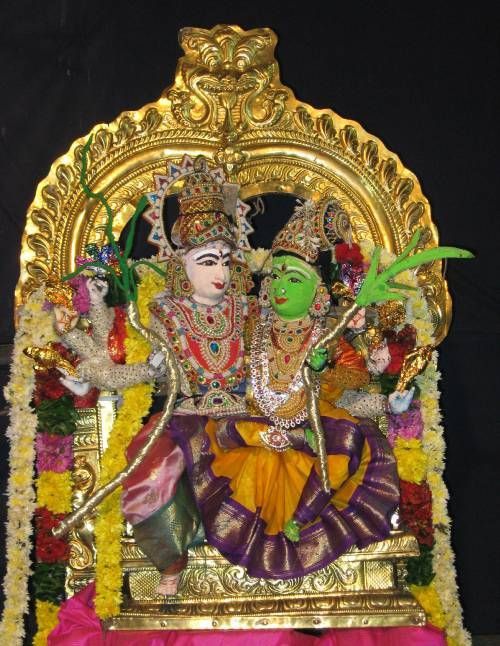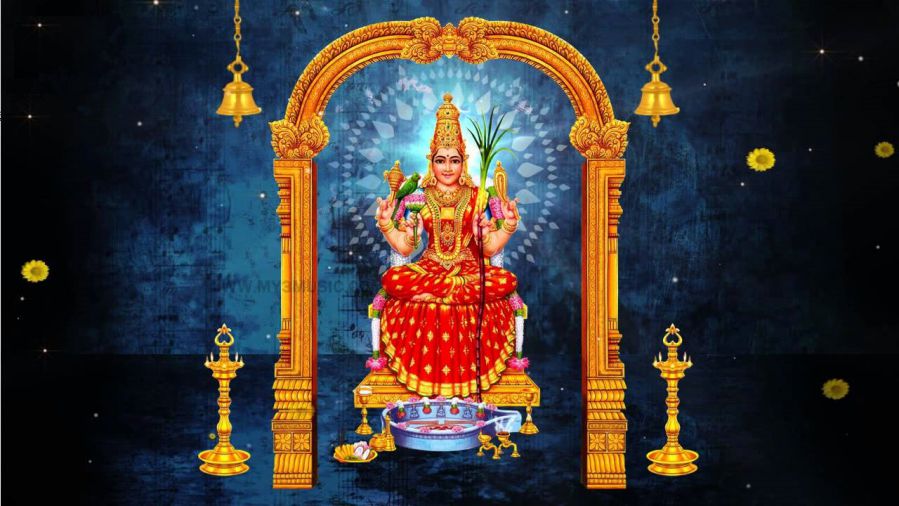No products in the cart.
Sri Lalitha Sahasranama is in the 36th chapter of Lalitopakyana in Brahmanda Purana. It is a hymn that describes the 1000 various names of Sree Lalitha and praises God as the Divine Mother or God’s Shakti or Power. It is presented in the form of instructions imparted to the Agasthya Maharishi by Hayagriva who is an incarnation of Sree Maha Vishnu. The Lalitha Purana explains about the manifestation of Goddess for the destruction of a demon called Banasura. It provides details about the construction of Sreepura, in the form of Sree Chakra. Sree Adi Sankaracharya and Sree Bhaskararaya had contributed commentaries for Trisati and Sahasranama.
She was extremely beautiful, having dark thick long hair with scent of Champak, Asoka and Punnaga flowers, having the musk thilaka on her forehead, Having eyelids which appeared as if it is the gate of the house of God of love, having eyes which were like fish playing in a beautiful crystal clear lake, Having nose with studs which shined more than the stars, Having ears with sun and moon as studs, having cheeks which were like mirror of the Padma raga, Having beautiful rows of white teeth, Chewing Thamboola with camphor, having voice sweeter than the sound emanating from the Veena of Saraswati. Having such a beautiful smile that Lord Shiva himself could not take his eyes off, Wearing Mangala soothra and necklaces with beautiful shining dollars, Having breasts which were capable of buying the invaluable love of Kameshwara, having row of faint beautiful hair raising from her belly, having stomach with three pretty folds, wearing red silk tied with a string with red bells. Having thighs which steal the heart of Kameshwara, Having knees which looked like crowns made of precious gems, having voluptuous legs, having upper part of the feet resembling the back of tortoise, Having feet which resembled the lamps made of gems which could dispel worries from the mind of devotees and a body with the golden red colour. She was given in marriage to Lord Kameshwara and made to stay in Sree Nagara at the top of Maha Meru Mountain.
Hayagriva recites the story of the incarnation of Sree Lalitha Devi to Agasthya Maharishi, where he describes the abode of Sree Lalitha (Sreepura), the Panchadashakshari, the unity of the Sree Yantra, Sree Vidya, Sree Lalithambika and Sree Guru. However, Hayagriva does not mention about Sree Lalitha Sahasranama. When Agasthya Maharishi repeatedly asks Hayagriva to enlighten him about the Lalitha Sahasranama, Hayagriva explains the reasons why Sree Lalitha Sahasranama is so divine and sacred, and finally tells him the reason as to why its knowledge has to be imparted to those who are highly potential and exalted. He also tells Agasthya Maharishi the reasons why it was not imparted initially.
The Story of Sree Lalitha

During the ancient times, there was a powerful demon named Taraka. He was controlling and lording over the Universe with his unequalled power and strength. A group of devas then resolved that only Skanda can destroy Taraka. But, due to the penance of Lord Siva, the birth of Skanda had been delayed. Manmata (the God of love) was assigned by the devas to wake up Lord Siva from his deep meditation. With the intention of performing his job, Manmata applied the flower – shafts of lust on Lord Siva, who then roused with uncontrollable anger and burnt Manmata with the energy of his Third eye. Another energy flame from Lord Siva’s third eye gave birth to Lord Skanda, who then destroyed Tarakasura.
However, due to the absence of Manmata, creation in the World had stopped. Realizing this, Lord Siva blessed Manmata for his rebirth. As he sprinkled the holy water over the ashes of Manmata, another demon named Banasura was accidentally created. The supreme strength of the demon spoiled the righteousness of the three worlds. Indra, the king of Devas performed a yagna according to the advice of Lord Siva and as a result of this yagna, Devi Sree Lalitha appeared, embodying the powers of creation, protection and destruction. The Devas praised her in eloquent terms as Universal Mother.
Lord Siva married her in the avatar of Kameshwara and the Kingdom of Sree Lalitha originated from the Sreepura, a beautiful city at the crest of the mount Meru, built in the form of Sree Chakra. In a fierce battle that lasted for a long time, Sree Lalitha destroyed Banasura.
The philosophical base of this unprecedented success of the Devi is that, the ‘ajnana’ (ignorance) is removed by ‘Jnana’ (realization).
Wisdom Behind the Story of Goddess Lalitha
Daksha means a skilled person, often we see that we get skills in many fields and in the process we sometimes knowingly or unknowingly get arrogance, due to this arrogance we ignore the divinity in us, who is represented by Lord Shiva. We often don’t listen to our conscience and fall to various trouble. Dakshas daughter Sati is representing the energy of the divinity, the truthfulness, who gets married to Shiva. When arrogance in us reaches its peak and ignores totally our consciousness, insulting it, then Sati, the truthfulness sacrifices herself…in arrogance we often don’t see the truthfulness of us or others and act in a manner which brings miseries to us and around us.
Once the tragedy happens out of arrogance, then our conscience pricks us, this is represented by Lord Shiva punishing Daksha. Later, as lust (Manmatha) peaks and try to affect our conscience, two things can happen, either fall in to the sensations of lust or control ourselves by killing the lustful desires, same thing is represented by Lord Shiva killing Manmatha by the fire of his third eye, then when gods pray, he revives him but lust now takes the form of Banasura, the anger resulting out of unfulfilled lustful desires.
Bandakasura and Manmatha, endowed with Thamoguna and Rajoguna respectively, are personifications of anger and lust. Unfulfilled lust leads to anger and Desire is the root cause of misery. One should strive to overcome these two qualities. Though both anger and desire cannot be completely effected, they can be kept under proper check without causing any hindrance to the practice of Dharma with the grace of Goddess Shri Lalitha Tripura Sundari, Sri Kamakshi. The three gunas namely Sathvaguna, Rajoguna and Thamoguna signify judicious action, indiscriminate action, and inaction respectively. By vanquishing Bandakasura and subduing Manmatha, Goddess Sri Kamakshi (one who fulfills the desires of her devotees) demonstrated to the entire world the futility of inaction the need for careful avoidance of indiscretection and the importance of incidences in judulgence action.
So this anger is later killed by the shakti of the divine by raising our consciousness from lustful desires and anger to the state of bliss, a bliss, which is the blessings received by reciting the thousand names of Shakti , Sri Lalitha Tripura Sundari. Thus, showing how we can turn our various material and lustful filled desires in to inward blissful state of consciousness, merging of the Shakti with Shiva in us, atmarathi.
The Significance of Sree Lalitha Sahasranama
• Sree Lalitha Sahasranama, is most pleasing to Sree Lalitha Parameshvari. There is nothing to equal this in the Vedas or Tantras.
• The daily chanting of this hymn gives the same merit as that obtained from bathing in holy rivers and giving gifts of wealth, food, land and cows.
• Barren women get the gift of children by taking ghee that has been made potent by chanting Lalitha Sahasranama.
• By daily chanting of the Sahasranama, the effects of evil spells are removed
• All the faults arising from not completing puja rituals or from not observing various rites on time are removed by the chanting of this hymn. This hymn may be chanted instead of various expiatory rituals.
• Relief from afflictions due to the influence of planets or evil spirits can be removed by chanting the Sahasranama while holding some water and then pouring that water over the head.
• Devi protects those who chant this hymn daily from dangers and from attacks by enemies. Victory in battle is gained through the chanting.
• Daily chanting of the Sahasranama augments prosperity, eloquence and fame.
• The Sahasranama may be chanted by those who are in any of the four stages of life (brahmacharya, grihastha, vanaprastha and sannyasa).
• By performing yagnas of Lalitha Sahasranama, the consolidation of dharma becomes possible in the Kali Yuga.
• It is difficult to please Devi without the chanting of Lalitha Sahasranama. Through this hymn, the sins accrued in many births are removed.







Pranamam,
Very useful information and thanks for sharing it.
Here I would like to share more information on Goddess Lalitha Sahasranamam.
Thanks.